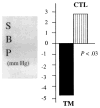Impact of Transcendental Meditation on cardiovascular function at rest and during acute stress in adolescents with high normal blood pressure
- PMID: 11595248
- PMCID: PMC3216051
- DOI: 10.1016/s0022-3999(01)00261-6
Impact of Transcendental Meditation on cardiovascular function at rest and during acute stress in adolescents with high normal blood pressure
Abstract
Objective: This study examined the impact of the Transcendental Meditation (TM) program on cardiovascular (CV) reactivity in adolescents with high normal BP.
Method: Thirty-five adolescents [34 African Americans (AAs), 1 Caucasian American (CA); ages 15-18 years] with resting systolic blood pressure (SBP) between the 85th and 95th percentile for their age and gender on three consecutive occasions, were randomly assigned to either TM (n=17) or health education control (CTL, n=18) groups. The TM group engaged in 15-min meditation twice each day for 2 months including sessions during school lunch break. Primary CV outcome measures were changes in blood pressure (BP), heart rate (HR), and cardiac output (CO) at rest and in response to two laboratory stressors, a simulated car driving stressor and an interpersonal social stressor interview.
Results: The TM group exhibited greater decreases in resting SBP (P<.03) from pre- to postintervention, compared to the CTL group. The TM group exhibited greater decreases from pre- to postintervention in SBP, HR, and CO reactivity (P's<.03) to the simulated car driving stressor, and in SBP reactivity (P<.03) to the social stressor interview.
Conclusion: The TM program appears to have a beneficial impact upon CV functioning at rest and during acute laboratory stress in adolescents at-risk for hypertension.
Figures



Similar articles
-
Impact of transcendental meditation on ambulatory blood pressure in African-American adolescents.Am J Hypertens. 2004 Apr;17(4):366-9. doi: 10.1016/j.amjhyper.2003.12.008. Am J Hypertens. 2004. PMID: 15062892 Free PMC article. Clinical Trial.
-
Acute effects of transcendental meditation on hemodynamic functioning in middle-aged adults.Psychosom Med. 1999 Jul-Aug;61(4):525-31. doi: 10.1097/00006842-199907000-00017. Psychosom Med. 1999. PMID: 10443761 Free PMC article.
-
Stress Reduction in the Prevention of Left Ventricular Hypertrophy: A Randomized Controlled Trial of Transcendental Meditation and Health Education in Hypertensive African Americans.Ethn Dis. 2019 Oct 17;29(4):577-586. doi: 10.18865/ed.29.4.577. eCollection 2019 Fall. Ethn Dis. 2019. PMID: 31641325 Free PMC article. Clinical Trial.
-
The impact of transcendental meditation on depressive symptoms and blood pressure in adults with cardiovascular disease: A systematic review and meta-analysis.Complement Ther Med. 2019 Oct;46:172-179. doi: 10.1016/j.ctim.2019.08.009. Epub 2019 Aug 16. Complement Ther Med. 2019. PMID: 31519275 Free PMC article.
-
Meditation and blood pressure: a meta-analysis of randomized clinical trials.J Hypertens. 2017 Apr;35(4):696-706. doi: 10.1097/HJH.0000000000001217. J Hypertens. 2017. PMID: 28033127 Review.
Cited by
-
Susceptibility of Women to Cardiovascular Disease and the Prevention Potential of Mind-Body Intervention by Changes in Neural Circuits and Cardiovascular Physiology.Biomolecules. 2021 May 10;11(5):708. doi: 10.3390/biom11050708. Biomolecules. 2021. PMID: 34068722 Free PMC article. Review.
-
Effect of transcendental meditation on employee stress, depression, and burnout: a randomized controlled study.Perm J. 2014 Winter;18(1):19-23. doi: 10.7812/TPP/13-102. Perm J. 2014. PMID: 24626068 Free PMC article. Clinical Trial.
-
Temporal stability of twenty-four-hour ambulatory hemodynamic bioimpedance measures in African American adolescents.Blood Press Monit. 2004 Aug;9(4):173-7. doi: 10.1097/00126097-200408000-00001. Blood Press Monit. 2004. PMID: 15311143 Free PMC article.
-
Clinical and Pre-clinical Applications of the Transcendental Meditation Program in the Prevention and Treatment of Essential Hypertension and Cardiovascular Disease in Youth and Adults.Curr Hypertens Rev. 2006 Aug 1;2(3):207-218. doi: 10.2174/157340206778132545. Curr Hypertens Rev. 2006. PMID: 22383899 Free PMC article.
-
Influences of Family Environment and Meditation Efficacy on Hemodynamic Function among African American Adolescents.J Complement Integr Med. 2010 Jul;7(1):1326. doi: 10.2202/1553-3840.1326. J Complement Integr Med. 2010. PMID: 22328869 Free PMC article.
References
-
- Burt VL, Whelton P, Rocella EJ, Brown C, Cutler JA, Higgins M, Horan MJ, Labarthe D. Prevalence of hypertension in the US adult population: results from the Third National Health and Nutrition Examination survey, 1988–1991. Hypertension. 1995;25:305–13. - PubMed
-
- Baron A, Freyer B, Fixler D. Longitudinal blood pressure in Blacks, Whites, and Mexican Americans during adolescence and early adulthood. Am J Epidemiol. 1986;123:809–17. - PubMed
-
- Gillman MW, Cook NR, Rosner B, Evans DA, Keough ME, Taylor JO, Hennekens CH. Identifying children at high risk for the development of essential hypertension. J Pediatr. 1993;1226:837–46. - PubMed
-
- Berenson GS, Wattigney WA, Bao W, Nicklas TA, Jiang X, Rush JA. Epidemiology of early primary hypertension and implications for prevention: the Bogalusa Heart Study. J Hum Hypertens. 1994;85:303–11. - PubMed
-
- Beckett LA, Rosner B, Roche AF, Guo S. Serial changes in blood pressure from adolescence into adulthood. Am J Epidemiol. 1992;13510:1166–77. - PubMed
Publication types
MeSH terms
Grants and funding
LinkOut - more resources
Full Text Sources
Medical

